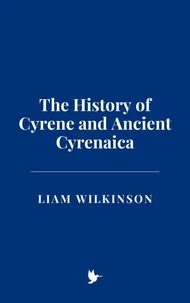History of the Roman Provinces in Africa
Par :Formats :
Disponible dans votre compte client Decitre ou Furet du Nord dès validation de votre commande. Le format ePub est :
- Compatible avec une lecture sur My Vivlio (smartphone, tablette, ordinateur)
- Compatible avec une lecture sur liseuses Vivlio
- Pour les liseuses autres que Vivlio, vous devez utiliser le logiciel Adobe Digital Edition. Non compatible avec la lecture sur les liseuses Kindle, Remarkable et Sony
 , qui est-ce ?
, qui est-ce ?Notre partenaire de plateforme de lecture numérique où vous retrouverez l'ensemble de vos ebooks gratuitement
Pour en savoir plus sur nos ebooks, consultez notre aide en ligne ici
- FormatePub
- ISBN8227081667
- EAN9798227081667
- Date de parution31/01/2025
- Protection num.pas de protection
- Infos supplémentairesepub
- ÉditeurBig Dog Books, LLC
Résumé
This book explores the intricate and multifaceted history of Roman Africa, from its initial conquest and integration into the Roman Empire to its eventual transformation under Islamic rule. Through twenty comprehensive chapters, it delves into the cultural, political, economic, religious, and military dynamics that defined North Africa's relationship with Rome, examining the Romanization process and the diverse interactions between Roman colonizers and indigenous Berber societies.
It covers key topics such as the establishment of Roman provinces, the role of Roman infrastructure and legal systems, and the development of Christianity as the dominant religion in the region. The book also highlights the resilience of local resistance movements, such as those led by Berber tribes, and the eventual shift in power as the Roman Empire declined and was replaced by the Vandals, Byzantines, and, ultimately, the Islamic caliphates.
The text places a particular emphasis on the continuing influence of Roman culture, including architecture, agriculture, and intellectual traditions, on the emerging Islamic civilization that took control of North Africa in the 7th century. By synthesizing primary sources, scholarly commentary, and historical analysis, this work not only chronicles the rise and fall of Roman authority in North Africa but also traces the enduring legacy of Roman civilization in shaping the medieval Islamic world.
The book highlights the complexity of cultural exchange, religious transformation, and political change, offering a nuanced understanding of how Roman Africa contributed to the larger historical processes that shaped the Mediterranean and beyond.
It covers key topics such as the establishment of Roman provinces, the role of Roman infrastructure and legal systems, and the development of Christianity as the dominant religion in the region. The book also highlights the resilience of local resistance movements, such as those led by Berber tribes, and the eventual shift in power as the Roman Empire declined and was replaced by the Vandals, Byzantines, and, ultimately, the Islamic caliphates.
The text places a particular emphasis on the continuing influence of Roman culture, including architecture, agriculture, and intellectual traditions, on the emerging Islamic civilization that took control of North Africa in the 7th century. By synthesizing primary sources, scholarly commentary, and historical analysis, this work not only chronicles the rise and fall of Roman authority in North Africa but also traces the enduring legacy of Roman civilization in shaping the medieval Islamic world.
The book highlights the complexity of cultural exchange, religious transformation, and political change, offering a nuanced understanding of how Roman Africa contributed to the larger historical processes that shaped the Mediterranean and beyond.
This book explores the intricate and multifaceted history of Roman Africa, from its initial conquest and integration into the Roman Empire to its eventual transformation under Islamic rule. Through twenty comprehensive chapters, it delves into the cultural, political, economic, religious, and military dynamics that defined North Africa's relationship with Rome, examining the Romanization process and the diverse interactions between Roman colonizers and indigenous Berber societies.
It covers key topics such as the establishment of Roman provinces, the role of Roman infrastructure and legal systems, and the development of Christianity as the dominant religion in the region. The book also highlights the resilience of local resistance movements, such as those led by Berber tribes, and the eventual shift in power as the Roman Empire declined and was replaced by the Vandals, Byzantines, and, ultimately, the Islamic caliphates.
The text places a particular emphasis on the continuing influence of Roman culture, including architecture, agriculture, and intellectual traditions, on the emerging Islamic civilization that took control of North Africa in the 7th century. By synthesizing primary sources, scholarly commentary, and historical analysis, this work not only chronicles the rise and fall of Roman authority in North Africa but also traces the enduring legacy of Roman civilization in shaping the medieval Islamic world.
The book highlights the complexity of cultural exchange, religious transformation, and political change, offering a nuanced understanding of how Roman Africa contributed to the larger historical processes that shaped the Mediterranean and beyond.
It covers key topics such as the establishment of Roman provinces, the role of Roman infrastructure and legal systems, and the development of Christianity as the dominant religion in the region. The book also highlights the resilience of local resistance movements, such as those led by Berber tribes, and the eventual shift in power as the Roman Empire declined and was replaced by the Vandals, Byzantines, and, ultimately, the Islamic caliphates.
The text places a particular emphasis on the continuing influence of Roman culture, including architecture, agriculture, and intellectual traditions, on the emerging Islamic civilization that took control of North Africa in the 7th century. By synthesizing primary sources, scholarly commentary, and historical analysis, this work not only chronicles the rise and fall of Roman authority in North Africa but also traces the enduring legacy of Roman civilization in shaping the medieval Islamic world.
The book highlights the complexity of cultural exchange, religious transformation, and political change, offering a nuanced understanding of how Roman Africa contributed to the larger historical processes that shaped the Mediterranean and beyond.























